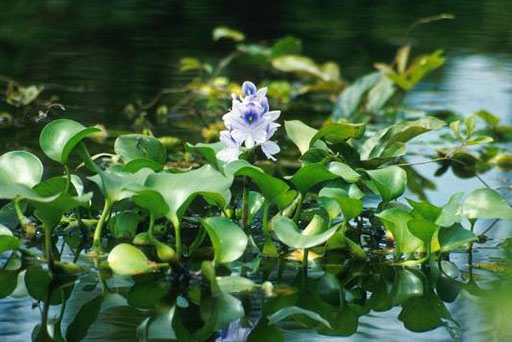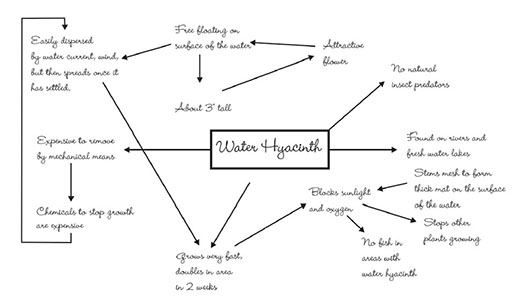Resource 1: Mind mapping
![]()
![]() Example of pupils’ work / Background information / subject knowledge for teacher
Example of pupils’ work / Background information / subject knowledge for teacher
Observations on the water hyacinth – an example from the class
Background information on the water hyacinth
Water hyacinth, Eichhornia crassipes, is a free-floating perennial herb. The plants grow about 3 feet tall as they float on the water’s surface, with stems intertwining to form dense mats.

Out of its enemies’ reach (mechanical/chemical removal or strong water flow/wind), the water hyacinth has become one of the most troublesome floating aquatic weeds in many tropical and subtropical parts of the Americas, Asia, Australia, and Africa. In Africa, it infests every major river and nearly every major freshwater lake.
Water hyacinth damages water quality by blocking sunlight and oxygen and slowing the water’s flow. Capable of doubling within a couple of weeks, it can grow faster than any other plant. By choking out other vegetation, it makes an area unusable by plants and animals that live in or depend on the water. Fish spawning areas may vanish.
Uncontrolled, water hyacinth robs water from potential drinking and irrigation supplies. The mats can block boat travel. Chunks of mat can break free to clog downstream pump stations supplying water for drinking, irrigation and hydropower.
Chemicals and mechanical removal, the primary weapons against the weed, are costly and often ineffective.
Lake Victoria’s water hyacinth problem
No one’s sure how the South America water hyacinth invaded Africa’s Lake Victoria but there’s little doubt as to the damage it has caused. In 1989, the weed was spotted in the lake and seven years later, it had clogged 80% of Uganda’s shoreline. Freed from its natural insect enemies, it continued to spread. Getting to fishing grounds became a terrible struggle. A reduced catch and lowered income threatened to trigger widespread famine. Rotting vegetation, under the suffocating blanket of weeds, began to foul drinking water – which comes straight from the lake. Meanwhile, along the edges of the floating weeds, water snails harbouring the deadly schistosomiasis parasite found a new place to breed.
James Ogwang – decided to spoil the party
Ogwang, a scientist from Uganda, imported another invasive species – a voracious South American weevil and natural enemy of the water hyacinth. Ogwang tested to see if his new tiny imports would solely attack the water hyacinth and not any local crops. Satisfied with their specificity, he released his tiny army and they got to work.
Adapted from: Watch out Water Hyacinths New Jungle Enemies are Coming’
3. Organising open-ended project work




